KIA Sportage 2006 JE_ / 2.G Owner's Guide
Manufacturer: KIA, Model Year: 2006, Model line: Sportage, Model: KIA Sportage 2006 JE_ / 2.GPages: 354, PDF Size: 3.62 MB
Page 21 of 354
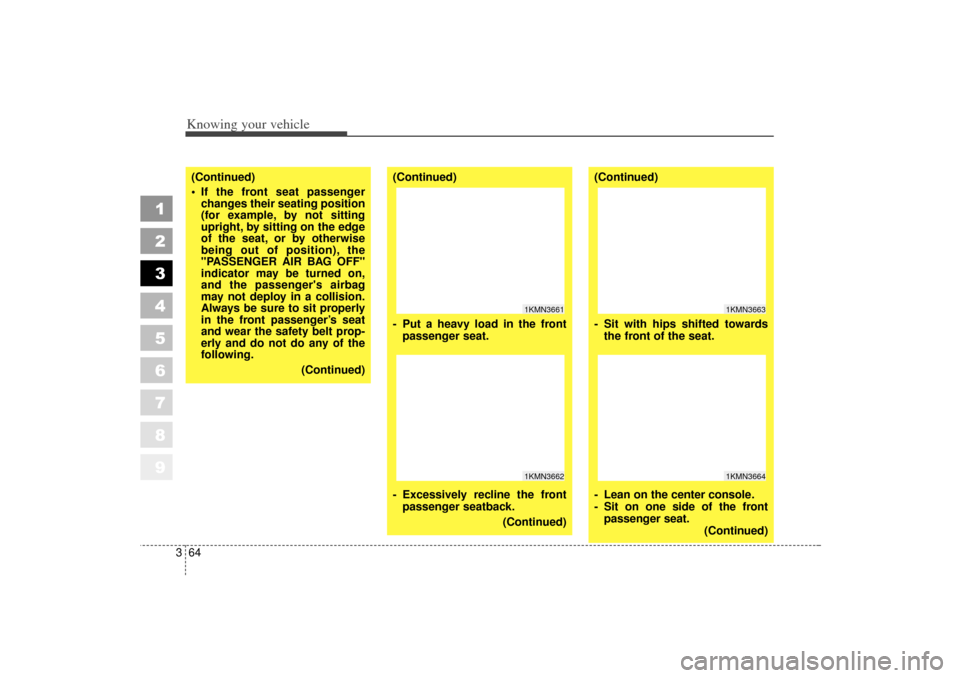
Knowing your vehicle64
3
1
2
3
4
5
6
7
8
9
(Continued)
If the front seat passenger
changes their seating position
(for example, by not sitting
upright, by sitting on the edge
of the seat, or by otherwise
being out of position), the
"PASSENGER AIR BAG OFF"
indicator may be turned on,
and the passenger's airbag
may not deploy in a collision.
Always be sure to sit properly
in the front passenger’s seat
and wear the safety belt prop-
erly and do not do any of the
following.
(Continued)
(Continued)
- Put a heavy load in the frontpassenger seat.
- Excessively recline the front passenger seatback.
(Continued)
1KMN36611KMN3662
(Continued)
- Sit with hips shifted towardsthe front of the seat.
- Lean on the center console.
- Sit on one side of the front passenger seat. (Continued)
1KMN36631KMN3664
KM CAN (ENG) 3 (55~)new.qxd 7/29/05 9:37 AM Page 64
Page 22 of 354
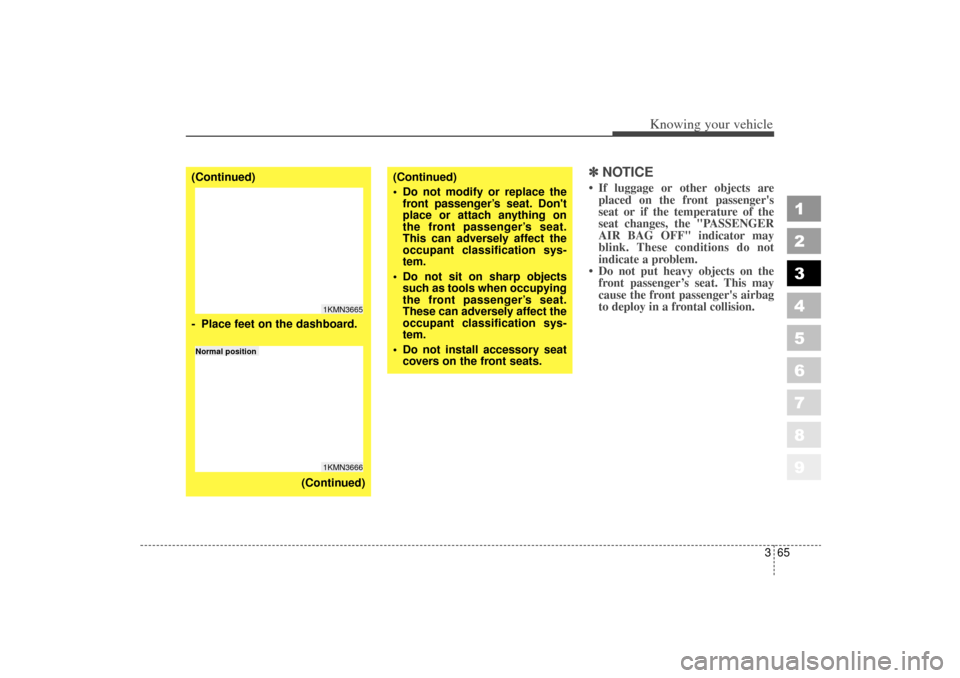
365
1
2
3
4
5
6
7
8
9
Knowing your vehicle
✽ ✽NOTICE• If luggage or other objects are
placed on the front passenger's
seat or if the temperature of the
seat changes, the "PASSENGER
AIR BAG OFF" indicator may
blink. These conditions do not
indicate a problem.
Do not put heavy objects on the front passenger’s seat. This may
cause the front passenger's airbag
to deploy in a frontal collision.
(Continued)
Do not modify or replace the
front passenger’s seat. Don't
place or attach anything on
the front passenger’s seat.
This can adversely affect the
occupant classification sys-
tem.
Do not sit on sharp objects such as tools when occupying
the front passenger’s seat.
These can adversely affect the
occupant classification sys-
tem.
Do not install accessory seat covers on the front seats.
(Continued)
- Place feet on the dashboard.
(Continued)
1KMN36651KMN3666
Normal position
KM CAN (ENG) 3 (55~)new.qxd 7/29/05 9:37 AM Page 65
Page 23 of 354
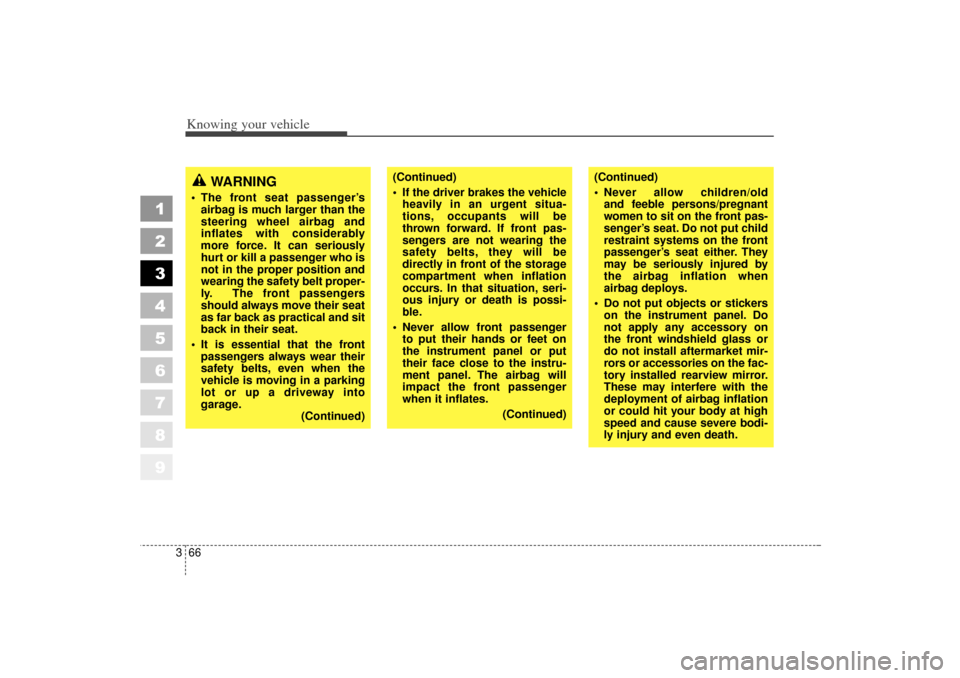
Knowing your vehicle66
3
1
2
3
4
5
6
7
8
9
(Continued)
If the driver brakes the vehicle
heavily in an urgent situa-
tions, occupants will be
thrown forward. If front pas-
sengers are not wearing the
safety belts, they will be
directly in front of the storage
compartment when inflation
occurs. In that situation, seri-
ous injury or death is possi-
ble.
Never allow front passenger to put their hands or feet on
the instrument panel or put
their face close to the instru-
ment panel. The airbag will
impact the front passenger
when it inflates.
(Continued)
(Continued)
Never allow children/old and feeble persons/pregnant
women to sit on the front pas-
senger’s seat. Do not put child
restraint systems on the front
passenger’s seat either. They
may be seriously injured by
the airbag inflation when
airbag deploys.
Do not put objects or stickers on the instrument panel. Do
not apply any accessory on
the front windshield glass or
do not install aftermarket mir-
rors or accessories on the fac-
tory installed rearview mirror.
These may interfere with the
deployment of airbag inflation
or could hit your body at high
speed and cause severe bodi-
ly injury and even death.
WARNING
The front seat passenger’sairbag is much larger than the
steering wheel airbag and
inflates with considerably
more force. It can seriously
hurt or kill a passenger who is
not in the proper position and
wearing the safety belt proper-
ly. The front passengers
should always move their seat
as far back as practical and sit
back in their seat.
It is essential that the front passengers always wear their
safety belts, even when the
vehicle is moving in a parking
lot or up a driveway into
garage. (Continued)
KM CAN (ENG) 3 (55~)new.qxd 7/29/05 9:37 AM Page 66
Page 24 of 354
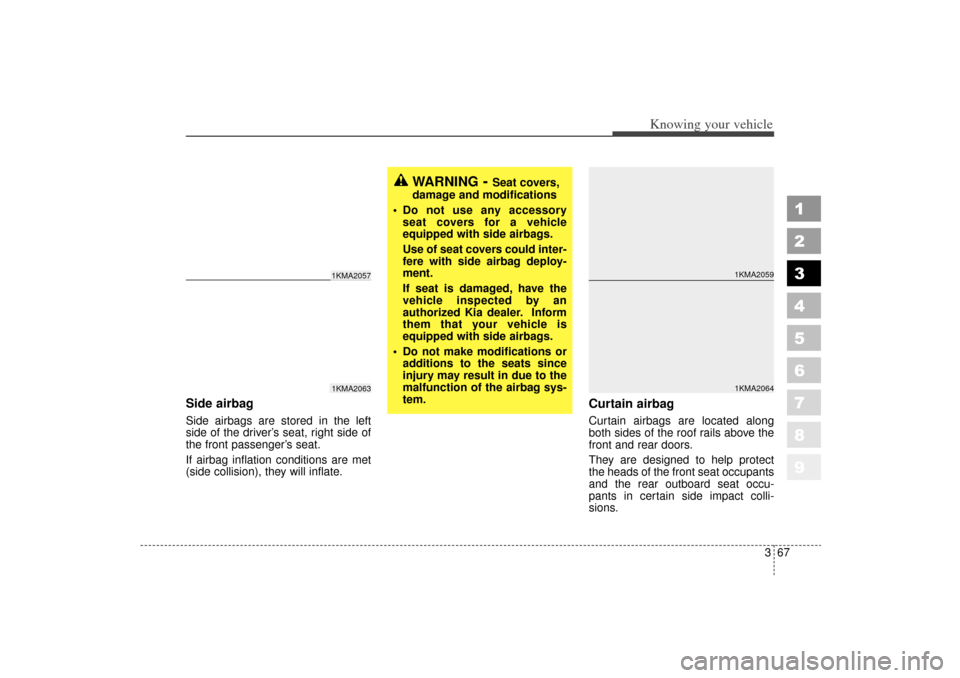
367
1
2
3
4
5
6
7
8
9
Knowing your vehicle
Side airbagSide airbags are stored in the left
side of the driver’s seat, right side of
the front passenger’s seat.
If airbag inflation conditions are met
(side collision), they will inflate.
Curtain airbagCurtain airbags are located along
both sides of the roof rails above the
front and rear doors.
They are designed to help protect
the heads of the front seat occupants
and the rear outboard seat occu-
pants in certain side impact colli-
sions.
WARNING
- Seat covers,
damage and modifications
Do not use any accessory seat covers for a vehicle
equipped with side airbags.
Use of seat covers could inter-
fere with side airbag deploy-
ment.
If seat is damaged, have the
vehicle inspected by an
authorized Kia dealer. Inform
them that your vehicle is
equipped with side airbags.
Do not make modifications or additions to the seats since
injury may result in due to the
malfunction of the airbag sys-
tem.
1KMA20631KMA2057
1KMA20591KMA2064
KM CAN (ENG) 3 (55~)new.qxd 7/29/05 9:37 AM Page 67
Page 25 of 354
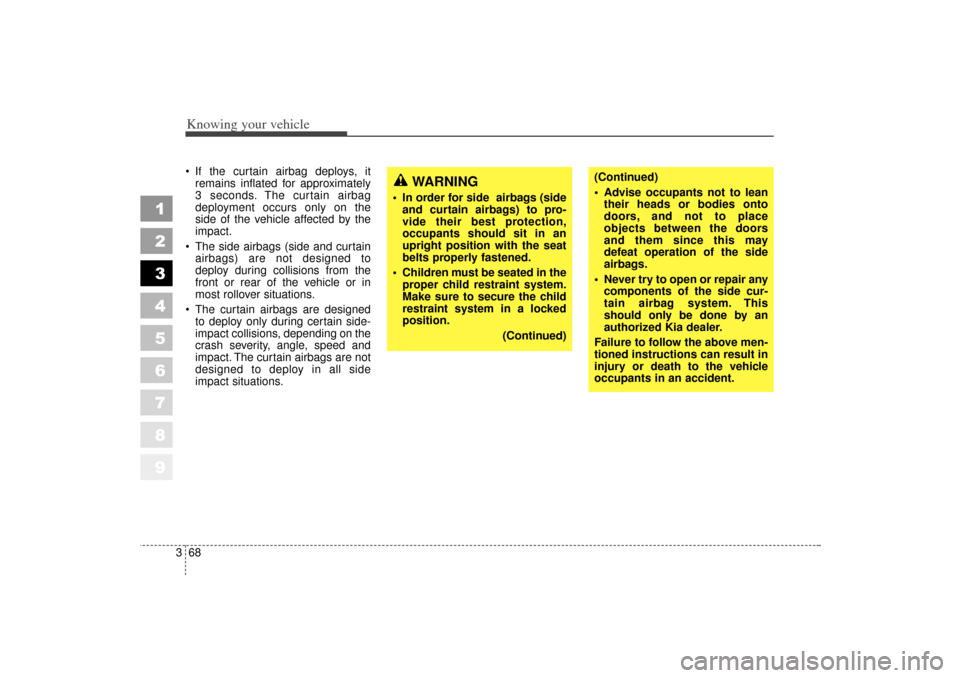
Knowing your vehicle68
3
1
2
3
4
5
6
7
8
9
If the curtain airbag deploys, it
remains inflated for approximately
3 seconds. The curtain airbag
deployment occurs only on the
side of the vehicle affected by the
impact.
The side airbags (side and curtain airbags) are not designed to
deploy during collisions from the
front or rear of the vehicle or in
most rollover situations.
The curtain airbags are designed to deploy only during certain side-
impact collisions, depending on the
crash severity, angle, speed and
impact. The curtain airbags are not
designed to deploy in all side
impact situations.
WARNING
In order for side airbags (sideand curtain airbags) to pro-
vide their best protection,
occupants should sit in an
upright position with the seat
belts properly fastened.
Children must be seated in the proper child restraint system.
Make sure to secure the child
restraint system in a locked
position.
(Continued)
(Continued)
Advise occupants not to leantheir heads or bodies onto
doors, and not to place
objects between the doors
and them since this may
defeat operation of the side
airbags.
Never try to open or repair any components of the side cur-
tain airbag system. This
should only be done by an
authorized Kia dealer.
Failure to follow the above men-
tioned instructions can result in
injury or death to the vehicle
occupants in an accident.
KM CAN (ENG) 3 (55~)new.qxd 7/29/05 9:37 AM Page 68
Page 26 of 354

369
1
2
3
4
5
6
7
8
9
Knowing your vehicle
Why didn’t my airbag go off in
a collision? (Inflation and non-inflation condi-
tions of the airbag)
There are many types of accidents
in which one or more of the
airbags would not be expected to
provide additional protection.
These include rear impacts, sec-
ond or third collisions in multiple
impact accidents, as well as low
speed impacts. Just because your
vehicle is damaged and even if it
is totally unusable, don’t be sur-
prised that the airbags did not
inflate.Airbag collision sensors
➀\f
SRS control module
➁\f
Front impact sensor
➂\f
Side impact sensor (if equipped)1KMA2065/1KMB2062/1KMA2061/1KMA2060
➀
➁
➂
KM CAN (ENG) 3 (55~)new.qxd 7/29/05 9:37 AM Page 69
Page 27 of 354

Knowing your vehicle70
3
1
2
3
4
5
6
7
8
9
Airbag inflation condition
Front airbag
Front airbags are designed to inflate
when the impact is delivered to front
collision sensors depending on the
intensity, speed or angles of impact
of the front collision - generally from
an area a little to the left to a little to
the right of straight ahead.
WARNING
- Protecting
airbag module and sensors
Do not hit or allow any heavy objects to hit the locations
where airbags or sensors are
installed.
This may cause damage and
unexpected airbag deploy-
ment, which could result in
serious personal injury or
death.
If the installation location or angle of the sensors is altered
in any way, the airbags may
malfunction, causing severe
injury or death.
Therefore, do not try to per-
form maintenance on or
around the airbag sensors.
Have the vehicle repaired by
an authorized Kia dealer.
WARNING
- Body
changes
Problems may arise if the sen- sor installation angles are
changed due to the deforma-
tion of front bumper, body or B
pillar where side collision sen-
sors are installed. In the event
of a collision, have the vehicle
inspected by an authorized
Kia dealer.
Your vehicle has been designed to deploy the
airbag(s) in certain collisions.
Installing aftermarket bumper
guards or replacing a bumper
with non-genuine parts may
adversely affect your vehicle’s
airbag deployment perform-
ance.
1KMA2066
KM CAN (ENG) 3 (55~)new.qxd 7/29/05 9:37 AM Page 70
Page 28 of 354

371
1
2
3
4
5
6
7
8
9
Knowing your vehicle
Side airbag
Side airbags (side and curtain
airbags) are designed to inflate
depending on the strength, speed
and angles of impact of a side impact
collision or rollover.If the vehicle chassis is impacted by
bumps or objects on unimproved
roads or sidewalks, airbags may
deploy. Drive carefully on unim-
proved roads or on surfaces not
designed for vehicle traffic to prevent
unintended airbag deployment.
Airbag non-inflation conditions
In certain low-speed collisions theairbags may not deploy. The
airbags are designed not to deploy
in such cases because the risk of
injuries which can be caused by
the airbags exceeds the benefits
they provide in protecting occu-
pants.
1KMN20671KMB2064
1KMA2068
KM CAN (ENG) 3 (55~)new.qxd 7/29/05 9:37 AM Page 71
Page 29 of 354

Knowing your vehicle72
3
1
2
3
4
5
6
7
8
9
In this case, the front airbags do
not provide protection, since they
would instantaneously inflate and
deflate while the occupants were
moving away from the front
airbags. Front airbags are also not general-
ly designed to deploy in side
impact collisions because occu-
pants are moving sideways ad not
forward into the front airbags.
However, side or curtain airbags
are designed to inflate in side
impacts depending on the intensi-
ty, vehicle speed and angles of
impact. In a slant or angled collision, the
force of impact may direct the
occupants in a direction between
the front and side airbags, and
thus the sensors may not deploy
any airbags.
1KMA2069
1KMA2070
1KMA2071
KM CAN (ENG) 3 (55~)new.qxd 7/29/05 9:37 AM Page 72
Page 30 of 354
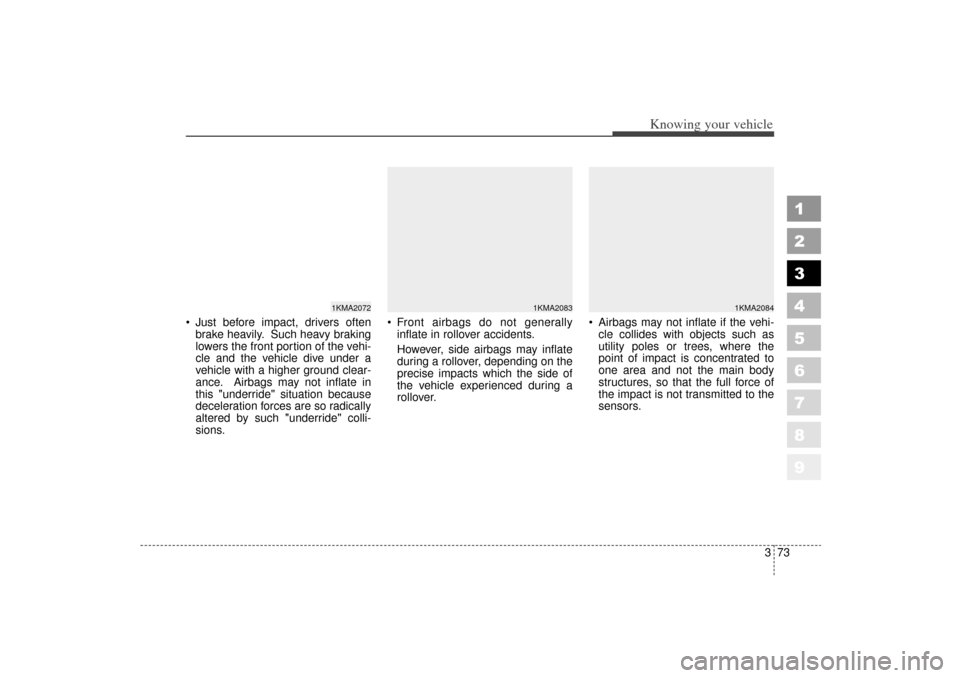
373
1
2
3
4
5
6
7
8
9
Knowing your vehicle
Just before impact, drivers oftenbrake heavily. Such heavy braking
lowers the front portion of the vehi-
cle and the vehicle dive under a
vehicle with a higher ground clear-
ance. Airbags may not inflate in
this "underride" situation because
deceleration forces are so radically
altered by such "underride" colli-
sions. Front airbags do not generally
inflate in rollover accidents.
However, side airbags may inflate
during a rollover, depending on the
precise impacts which the side of
the vehicle experienced during a
rollover. Airbags may not inflate if the vehi-
cle collides with objects such as
utility poles or trees, where the
point of impact is concentrated to
one area and not the main body
structures, so that the full force of
the impact is not transmitted to the
sensors.
1KMA2072
1KMA2083
1KMA2084
KM CAN (ENG) 3 (55~)new.qxd 7/29/05 9:37 AM Page 73